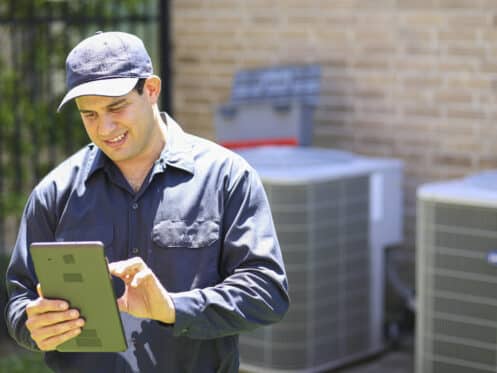Home heating systems use more energy than other systems in your home. These systems make up about 29% of monthly utility bills. You can reduce your home heating costs by picking an energy-efficient heating system combined with proper system maintenance and necessary efficiency home upgrades. Energy-efficient systems coupled with air sealing, necessary insulation, and the right thermostat settings will save money and reduce your carbon footprint. Consider any of these six options if you’re looking for an energy-efficient home heating option.
Active Solar Heating
An active solar heater heats liquid or air using solar energy. The heated fluid transfers the heat into your home, where it heats the space or is stored for later use. Liquid-based solar heaters use water or antifreeze to absorb solar heat. The liquid then moves through a collector with the aid of a circulating pump to heat the home. The liquid goes to a heat exchanger, where it instantly heats the home or to a storage tank for later use.
Air room heaters, on the other hand, use an airtight metal frame with a dark metal plate. The plate absorbs solar energy to heat the air inside the collector. The heat then circulates in the room via a blower or electric fan. You may need an auxiliary system if the active solar heater does not provide sufficient heating in your home.
Furnaces and Boilers
Most homeowners use furnaces and boilers to heat their spaces. Boilers heat water, which flows through pipes as steam or hot water to heat spaces. On the other hand, furniture heat air that flows through ducts to heat a home. Modern furnaces and boilers have a high-efficiency rating, making them cost-effective ways of heating a home.
Furnace and boiler manufacturers use annual fuel utilization efficiency (AFUE) ratings to show how efficient their systems are. The AFUE rating shows how effectively an appliance converts fuel to heat. If an appliance has an AFUE rating of 90%, it means that 90% of the energy from the fuel converts to heat while 10% escapes. Aim for systems with a high AFUE rating, such as all-electric furnaces that convert 100% of their energy to heat.
You can find gas and electric furnaces. Which type to choose may depend on your home and your region. Many modern electric furnaces have advanced technology that enhances their energy efficiency. Gas furnaces can be quite energy efficient, but they come with risks as they rely on burning fossil fuels. Natural gas or carbon monoxide buildup can happen with systems that are not properly installed or maintained. Plus, not all areas have municipal gas lines readily available, so gas furnaces are not always an option.
For boilers, opt for radiant heating. Radiant heating is more efficient than baseboard and forced-air heating as it eliminates duct losses. The radiant heating system is ideal for people with allergies as it does not distribute allergens like systems that use air fans. A homeowner can use radiant air floors, electric radiant floors, hot water radiant floors, or radiant panels placed on walls. Air radiant heating is less energy efficient as air holds less heat. Hydronic radiant heating, where hot water from the boiler passes through pipes to heat a floor, is more effective.
Modern Wood and Pellet Heating
Modern wood and pellet-burning appliances offer cleaner, more efficient, and powerful home heating systems. These are ideal for heating average-sized homes. Pellet heating systems burn pellets that are about an inch long or smaller.
To ensure the efficiency of wood and pellet heating systems, you need to pick the right size. An oversized system will lead to heat loss as homeowners tend to let the fire slowly smolder to reduce overheating. If the system is undersized, it will not adequately heat your space. Pick a stove rate of 42,000 British Thermal Units (BTU) to heat a 1,300-square-foot home and a 60,000 BTU stove for a 2,000-square-foot home.
Pick a wood-burning appliance certified by the United States Environmental Protection Agency (EPA). The downside with wood and pellet heating systems is that they produce smoke. As such, some municipalities might restrict their use.
Heat Pumps
Instead of burning fossil fuels, heat pumps draw heat from outdoor air, the ground, or water to heat a home. The key to their efficiency is heat transfer vs heat generation. Heat pumps often use the same air ducts as central AC and heaters. During the summer, the heat pump reverses the refrigerant and acts as an air conditioner to make the home comfortable. The air-to-air heat pumps are not ideal for hot water generation.
Air-to-water heat pumps contain several units connected by pipes with refrigerant. The outdoor unit absorbs heat from the outside air. It transfers the heat to the indoor unit, which transmits the heat to a radiator or floor radiant heating system. You can also use the air-to-water heat pumps as a hot water heater.
Further, you can pick ground-source or solar-assisted heat pumps. Ground-source heat pumps draw heat from the ground using sensors. The sensors sit deep in the ground, where the temperatures are relatively higher. However, ground heat pumps require extensive installation work. With a solar-assisted heat pump, you can combine solar panels with heat pumps to heat a home adequately and produce hot water.
Mini-Split Systems
Sometimes, a central, ducted heating system is not practical. This may be true in older homes that don’t have an existing central climate control system. It can also be true for home additions and converted basements, garages, or attics.
A mini-split typically consists of one outdoor unit and one or more indoor air handlers. These are connected through small tubes or pipes that carry wires or refrigerant. The small air handlers are often mounted on a wall and have their own thermostat and sensors. With these systems, you can precisely control the temperature of each room or area of the house. You can enjoy significant energy savings because you can choose to keep areas you don’t use cooler.
Electric Resistance Baseboard or Wall Heating
Electric resistance heaters convert 100% of the incoming energy to heat. If you live in an area with few heating days or need a system to supplement the central heating system, these heaters will be cost-effective. You can also use electric resistance for a home addition where extending the existing central heating system is not practical.
Talk to Heating Experts
Sometimes, a combination of heating sources will ensure adequate heating in your home while ensuring energy efficiency and cost-effectiveness. Hunt’s Services in Tacoma, WA, offers installation, repair, and maintenance of heat pumps, furnaces, and air conditioning systems. We can also help with duct cleaning and indoor air quality solutions. You can turn to us for your plumbing and sewer needs, too.
Installing a new energy-efficient heating system can be an overwhelming experience. Our experts at Hunt’s Services will guide you through Tacoma, WA’s heat pump and furnace types and installation processes. If you need a system that circulates healthy air in your home while reducing utility bills and your carbon footprint, contact Hunt’s Services today.




